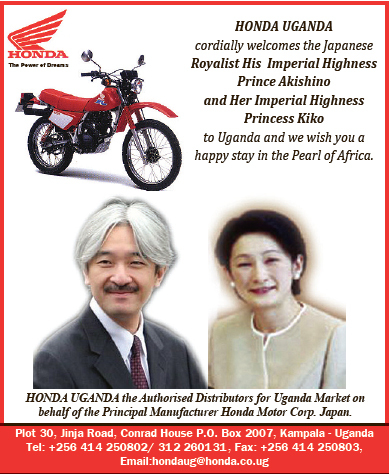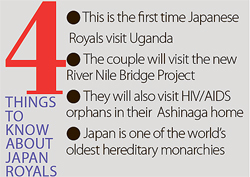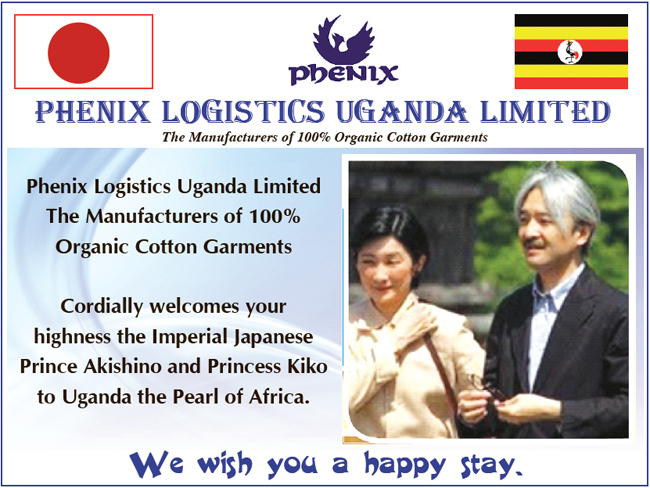Japan royals visit Uganda
Yesterday marked the day his Imperial Highness Prince and Her Imperial Highness Princess Akishino of Japan started a three-day visit to Uganda.

Japan, Uganda have had 50 years of relations
Yesterday marked the day his Imperial Highness Prince and Her Imperial Highness Princess Akishino of Japan started a three-day visit to Uganda. They will hold talks with President Museveni. The visit also marks the fi rst time that the Japanese royals are in Africa.
As reported earlier in New Vision, according to the ambassador of Uganda to Japan, Wasswa Biriggwa, the visit will commemorate 50 years of good relations with Japan. The couple are set to visit the new River Nile Bridge Project, which will be supported by the Government of Japan and Rice Research and Training Centre at Namulonge which was also supported by Japan.

As per the previous visits by Japanese foreign officials, this is a very important visit to Uganda following the longtime support and relations with the Japanese people. This trip is also aimed at strengthening diplomatic ties between the two nations. The royal family is also expected to visit the Phenix Logistics company owned a Japanese national.
 They will also visit Ashinaga, an international organisation that supports children orphaned by HIV/AIDS and the Uganda Wild Life Centre.
They will also visit Ashinaga, an international organisation that supports children orphaned by HIV/AIDS and the Uganda Wild Life Centre.Japan has supported Uganda in a number of projects ranging from programmes in health, agriculture, electricity, road construction to education. Prince Akishino is a member of the Japanese imperial family. He is the second son of the Emperor Akihito and the Empress Michiko and currently second-in-line to the Japanese throne.
Upon the death of his grandfather, the Emperor Showa, in January 1989, he became second-in-line to the throne after his elder brother, Crown Prince Naruhito. Since his marriage in June 1990, he has held the title of Prince and headed his own branch of the imperial family.
Prince Akishino received a PhD in ornithology from the Graduate University for Advanced Studies in October 1996. He conducted field research in Indonesia in 1993 and 1994 and in Yunnan Province in the People’s Republic of China. He is also the honorary president of the World Wide Fund for Nature Japan, the Japan Tennis Association, and the Japan-Netherlands Association. He is a visiting professor of Tokyo University of Agriculture.
Prince and Princess Akishino also foster friendly relations with foreign countries by representing Japan at select international events. According to Wikipedia, they travelled to the Netherlands in August 2009 to commemorate 400 years of trade between Holland and Japan. They were invited by the Dutch government and were hosted by Queen Beatrix in The Hague.
Japan is one of the world’s oldest hereditary monarchies. In much the same sense as the British Crown, it co-exists with legal authority for the existence of the government. Japan is a constitutional monarchy with a parliamentary government.

There is the extension of the right to vote to adult citizens with a secret ballot for all elective offices. Sovereignty, previously embodied in the emperor, is vested in the Japanese people..
The Emperor of Japan is “the symbol of the state and of the unity of the people” according to the 1947 Constitution of Japan, which dissolved the Empire of Japan when it was adopted by the Postwar Japanese government. He is a ceremonial fi gurehead under a form of constitutional monarchy and is head of the Japanese Imperial Family with functions as head of state. The Emperor’s Birthday is a national holiday.
According to legend, the Japanese monarchy is said to have been founded in 660 BC by Emperor Jimmu and the current Emperor is the 125th monarch to occupy the Chrysanthemum Throne.
The extant historical records only reach back to Emperor Ojin, who is considered to have reigned into the early 4th Century. In the 1920s, Hirohito served as Regent during several years of his father’s reign, when Emperor Taish was physically unable to fulfi ll his Imperial duties. However, the Prince Regent lacked the symbolic powers of the throne which he could only attain after his father’s death.
The metonymic meanings of “Chrysanthemum Throne” encompass the modern monarchy and the chronological list of legendary and historical monarchs of Japan. It is a term with fungible uses.
The Emperor of Japan is “the symbol of the state and of the unity of the people” according to the 1947 Constitution of Japan, which dissolved the Empire of Japan when it was adopted by the Postwar Japanese government. He is a ceremonial fi gurehead under a form of constitutional monarchy and is head of the Japanese Imperial Family with functions as head of state. The Emperor’s Birthday is a national holiday.
According to legend, the Japanese monarchy is said to have been founded in 660 BC by Emperor Jimmu and the current Emperor is the 125th monarch to occupy the Chrysanthemum Throne.
The extant historical records only reach back to Emperor Ojin, who is considered to have reigned into the early 4th Century. In the 1920s, Hirohito served as Regent during several years of his father’s reign, when Emperor Taish was physically unable to fulfi ll his Imperial duties. However, the Prince Regent lacked the symbolic powers of the throne which he could only attain after his father’s death.
The metonymic meanings of “Chrysanthemum Throne” encompass the modern monarchy and the chronological list of legendary and historical monarchs of Japan. It is a term with fungible uses.